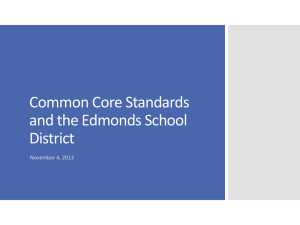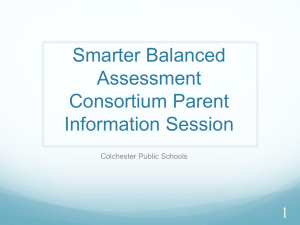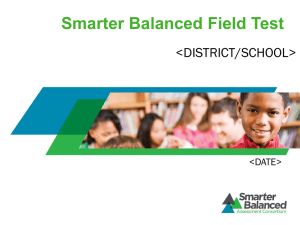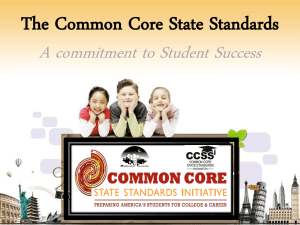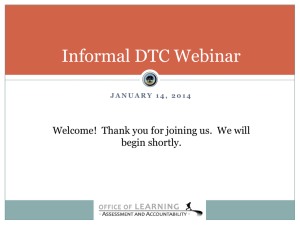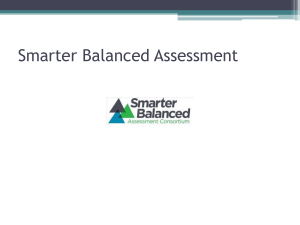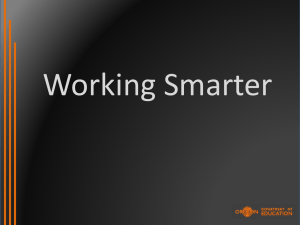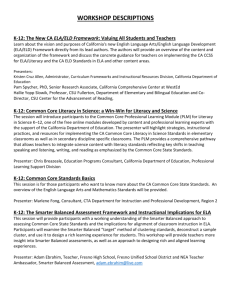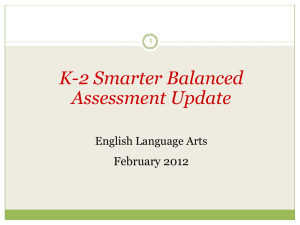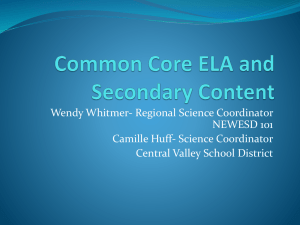Common Core State Standards and Smarter Balanced
advertisement
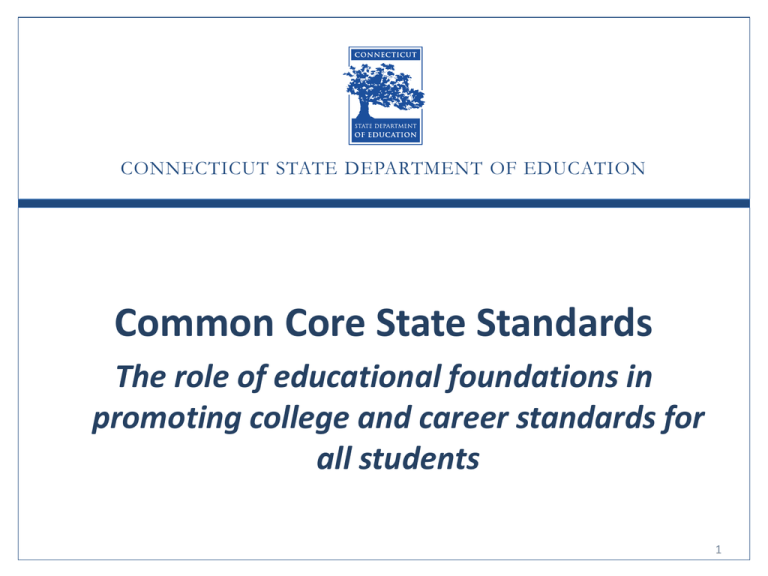
CONNECTICUT STATE DEPARTMENT OF EDUCATION Common Core State Standards The role of educational foundations in promoting college and career standards for all students 1 CT State Department of Education Core Beliefs 2 CT State Department of Education: Core Beliefs 3 Common Core State Standards & Smarter Balanced 4 What are the Common Core State Standards? 5 Common Core: Content Areas and Instructional Shifts 6 Common Core: English language arts and Literacy 7 Common Core Instructional Shifts: ELA • Building knowledge through content-rich nonfiction and informational texts Why are the instructional shifts in English language arts (ELA) important? 1. Much of our knowledge base comes from informational text. 2. Informational text makes up a vast majority of required reading in college/workplace (80%). 3. Informational text is harder for students to comprehend than narrative text. In K-5, fulfilling the Standards requires a 50-50 balance between informational and literary reading, informational reading primarily includes content rich non-fiction in history/social studies, science and the arts; the K-5 standards strongly recommend that students build coherent general knowledge both within each year and across years. In 6-12, ELA classes place much greater attention to a specific category of informational text—literary nonfiction—than has been traditional. In grades 6-12, the Standards for literacy in history/social studies, science and technical subjects ensure that students can independently build knowledge 8 in these disciplines through reading and writing. Common Core Instructional Shifts: ELA • Reading, writing and speaking grounded in evidence from text, both literary and informational The Standards place a premium on students writing to sources (i.e., using evidence from texts to present careful analyses, well-defended claims, and clear information). Rather than asking students questions they can answer solely from their prior knowledge or experience, the Standards expect students to answer questions that depend on their having read the text or texts with care. The Standards also require the cultivation of narrative writing throughout the grades, and in later grades a command of sequence and detail will be essential for effective argumentative and informational writing. Likewise the reading standards focus on students’ ability to read carefully and grasp information, arguments, ideals and details based on text evidence. Students should be able to answer a range of text-dependent questions, questions in which the answers require inferences based on careful attention to the text. 9 Common Core Instructional Shifts: ELA • Regular practice with complex text and its academic language The Standards build a staircase of text complexity so that all students are ready for the demands of college- and career-level reading no later than the end of high school. Students will read complex texts on their own and gather evidence, knowledge, and insight from those texts. read and reread passages, and respond to a series of text dependent questions, vocabulary and/or syntax tasks. Closely related to text complexity— and inextricably connected to reading comprehension—is a focus on academic vocabulary: words that appear in a variety of content areas. 10 Common Core Instructional Shifts: Math • Focus Strongly where the Standards focus Significantly narrow the scope of content and deepen how time and energy is spent in the math classroom—move away from "mile wide, inch deep" curricula. Focus deeply only on what is emphasized in the standards, so that students gain strong foundations—teach less, learn more. K – Counting, Sequencing, Value, Measurement 1st & 2nd – Adding, Subtracting-Whole numbers & Quantity 3rd – Multiplication, Division, Fractions 4th, 5th – Fractions…moving to ratios at the very end 11 Mathematics: Traditional U.S. Approach to Math 12 Mathematics: Common Core Approach to Math 13 Common Core Instructional Shifts: Math • Coherence: Think across grades, and link to major topics within grades Carefully connect the learning within and across grades so that students can build new understanding onto foundations built in previous years. Begin to count on solid conceptual understanding of core content and build on it. Each standard is not a new event, but an extension of previous learning. Fraction example: “The coherence and sequential nature of mathematics dictate the foundational skills that are necessary for the learning of algebra. The most important foundational skill not presently developed appears to be proficiency with fractions (including decimals, percents, and negative fractions). The teaching of fractions must be acknowledged as critically important and improved before an increase in student achievement in algebra can be expected.” Final Report of the National Mathematics Advisory Panel (2008, p. 18) Grade 3 Example: The standards make explicit connections at a single grade 14 Common Core Instructional Shifts: Math • Rigor: In major topics, pursue conceptual understanding, procedural skill and fluency, and application The CCSSM require a balance of: Solid conceptual understanding—Teachers support students’ ability to access concepts from a number of perspectives so that students are able to see math as more than a set of mnemonics or discrete procedures. Procedural skill and fluency—Teachers structure class time and/or homework time for students to practice core functions such as singledigit multiplication so that students have access to more complex concepts and procedures. Application of skills in problem solving situations—Teachers provide opportunities for students to apply math in context. Teachers in context areas outside of math, particularly in science, ensure that students are using math to make meaning of and access content. This requires equal intensity in time, activities, and resources in pursuit of all three. 15 Required Mathematics Fluencies in K-6 Grade Standard K K.OA.5 Add/subtract within 5 1 1.OA.6 Add/subtract within 10 2.OA.2 Add/subtract within 20 (know single-digit sums from memory) 2.NBT.5 Add/subtract within 100 3.OA.7 Multiply/divide within 100 (know single-digit products from memory) 3.NBT.2 Add/subtract within 1000 4 4.NBT.4 Add/subtract within 1,000,000 5 5.NBT.5 Multi-digit multiplication 6 6.NS.2,3 2 3 Required Fluency Multi-digit division Multi-digit decimal operations 16 What is Smarter Balanced? 17 What is Smarter Balanced? 18 Smarter Balanced: ELA Content Specifications 19 Smarter Balanced: Math Content Specifications 20 College- and Career-Ready 21 22 The role of community organizations in this shift Alignment and Sustainability Review alignment If college and career readiness is a focus of investments: Consider adjusting application process or criteria Consider investing in projects that support the shifts Make supporting literature available Lend your credibility Network for maximum impact 23 More information about new standards Student Achievement Partners An excellent source for all things Common Core that may help district and school leaders in the implementation of Common Core. • Essential actions and CCSS-aligned tools for school and district leaders, which exist within a system of implementation and shouldn’t be considered as a sequential checklist • New Professional Development modules that are ready-to-use and include PowerPoints, videos, facilitator’s instructions, and hands-on activities—ideal for PD workshops, professional learning communities, and self-study. • Aligning Materials and Curriculum—Tools for evaluating and developing Common Corealigned materials, as well as free Common Core-aligned resources • CCSS Evidence Guides: Common Core-aligned practice made clear—These tools provide specific guidance for what the CCSS for ELA / literacy and math looks like in planning and practice; they are designed as developmental tools for teachers and those who support teachers. Use the Evidence Guides for: • Teacher self-reflection • Peer-to-peer observation and feedback • Instructional coaching • Common Core Resources for Parents—Materials developed for parents of K-12 students 24 More information on new assessments Smarter Balanced • Similar to the CSDE Common Core aligned Practice Assessment, the Smarter Balanced Assessment Consortium (Smarter Balanced) has last week released sets of example test questions for grades 3–8 and 11 in both English language arts/literacy and mathematics. The Smarter Balanced Practice Tests provide a preview of the types of questions that will be featured in the summative assessment beginning in 2014-15, including selectedresponse items, constructed-response items, technology-enhanced items, and performance tasks—extended activities that challenge students to apply their knowledge and skills to respond to real-world problems. The Practice Tests do not include all the features of the operational assessments; for example, although Smarter Balanced assessments will be computer adaptive, the Practice Tests follow a fixed-form model. Also, unlike the CSDE Common Core aligned Practice Assessment, students and teachers will not receive reports or scores from the Smarter Balanced Practice Tests. We encourage districts to take advantage of this tool as it will help students and parents become more familiar with assessment items found on the 2015 Smarter Balanced assessment. 25
